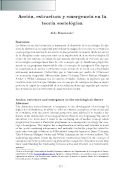Resultados: visualização detalhada
Registro 156 de 8.245 para a busca Tipo de documento Prensa y Revistas Y Institución Biblioteca Universitaria de Chile
Action, structure and emergency in the sociological theory
Aldo Mascareño; Universidad de Chile
2008
- Dados de edição Revista de Sociología; No. 22 (2008)
- Tipo de Documento Prensa y Revistas
-
Descrição
The distinction action/structure is immanent to the development of sociology. Its high level of abstraction, its ability to offer an ordered conception of the social, and its correlation with the actor's internal perspective, have allowed it to remain a key feature of the architecture of sociological theory from its very beginning. The aim of this article is to revise how it reacts to the increasing use of another concept which progress ...The distinction action/structure is immanent to the development of sociology. Its high level of abstraction, its ability to offer an ordered conception of the social, and its correlation with the actor's internal perspective, have allowed it to remain a key feature of the architecture of sociological theory from its very beginning. The aim of this article is to revise how it reacts to the increasing use of another concept which progressively becomes a transversal programme in contemporary sociology: the concept of emergence. This implies the comprehension of action and structure as levels of the social containing autonomous and mutually irreducible properties related to each other through irritations in differentiated temporal sequences. James Coleman, Talcott Parsons, Margaret Archer and Niklas Luhmann are the reviewed authors. The underlying hypothesis is that the theoretical constructions based on the concept of emergence are better positioned to apprehend the complexity of modern society than those understanding the relationship between action and structure in a reductionistic manner.La distinción acción/estructura es inmanente al desarrollo de la sociología. Su alto nivel de abstracción, su capacidad para ordenar la imagen de lo social y su correlación con la perspectiva interna de los actores, le han permitido sostenerse desde los inicios de la disciplina como una pieza clave en la arquitectura de la teoría sociológica. El objeto de este artículo es evaluar de qué manera ella responde al creciente uso que la socio ...La distinción acción/estructura es inmanente al desarrollo de la sociología. Su alto nivel de abstracción, su capacidad para ordenar la imagen de lo social y su correlación con la perspectiva interna de los actores, le han permitido sostenerse desde los inicios de la disciplina como una pieza clave en la arquitectura de la teoría sociológica. El objeto de este artículo es evaluar de qué manera ella responde al creciente uso que la sociología contemporánea hace de otro concepto que se transforma progresivamente en un programa transversal de ella: el concepto de emergencia. Este supone la comprensión de acción y estructura como niveles de lo social con propiedades autónomas mutuamente irreductibles que se relacionan por medio de irritaciones en secuencias temporales diferenciadas. James Coleman, Talcott Parsons, Margaret Archer y Niklas Luhmann son los autores revisados. Subyace la hipótesis que las construcciones teóricas que trabajan con el concepto de emergencia están en mejor posición de captar la complejidad de la sociedad moderna que aquellas que entienden la relación acción/estructura de manera reduccionista.Centro Interdisciplinario de Estudios en Bioética
- Identificador 41979
- Enlace a todos los ejemplares de la revista










